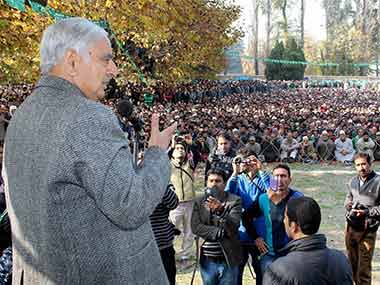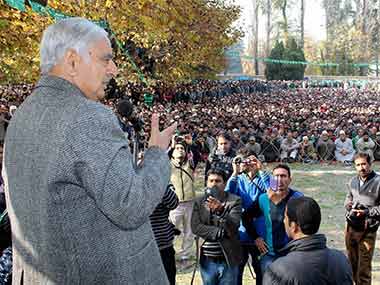Mufti Mohammed Sayeed could not have been more candid than when he said a BJP-PDP government in Jammu & Kashmir was like the “coming together of the North Pole and South Pole”. 1 March will thus be a watershed moment in contemporary Indian political history when the two poles join up to form a coalition government in the state. The swearing-in ceremony of PDP boss Sayeed as Chief Minister and BJP leader Nirmal Singh as Deputy Chief Minister, with virtually an equal number of ministers from both parties, signals not just the formation of a new government, but a shift in the political equations of the state. The fact that the BJP has not insisted on a rotational system of chief ministers - 12 years ago, this was the formula agreed by PDP and Congress to form a coalition government - implies that the BJP is now concerned more about stability in the state and sending the right message in the nation. [caption id=“attachment_2126333” align=“alignleft” width=“380”]  Mufti Mohammed Syeed in a file photo. PTI[/caption] It’s common knowledge that PDP and BJP have ideologically differed on almost all the issues that have historically been contentious in Muslim majority state: Article 370, the Armed Forces Special Powers Act, the status of of the separatist Hurriyat Conference, and dialogue with Pakistan, among other things. For BJP, Jammu & Kashmir has always been a core ideological issue — `Ek desh mein do Vidhan, do Pradhan aur Do Nishan nahi chalega’ (A single country can’t have two constitutions, two prime ministers and two national emblems). Its emotional connect with the state comes from the rather unfortunate circumstance in which the party’s founder, Dr Syama Prasad Mookerjee, died about 62 years ago. From that kind of ideological position to acquiring a share of formal power in the state is thus a huge moment of triumph for the BJP. Interestingly, the person who negotiated with the PDP on behalf of the BJP was Ram Madhav, an RSS Swayamsewak. From the PDP side, the negotiations were led by Haseeb Drabu, an economist turned politician and former Chairman of J&K Bank. The profile of negotiators will ensure that there is no negative fallout in the ranks of hard core believers in both parties, even if there is a bit of discomfort on either side. “Prime Minister Narendra Modi knows the issues, I know the issues”, Sayeed said, adding that the two sides had begun negotiating two days after the assembly election results were out on 25 December. With Jammu voting overwhelmingly for BJP and the Kashmir Valley largely for PDP, it was clear that the two regions gave different mandates. Making it work was not going to be an easy task. “It was a war of nerves. But we have come together. One has to be flexible. Yeh karna hota hai aur humne ye kiya hai (this had to be done and we have done that)”, Sayeed said after meeting Modi for over an hour at his official residence in New Delhi. Sayeed, who will become the CM for the second time, looked happy, and naturally so. The PDP actually did quite well even in 2008, but the Congress chose to switch loyalties to the National Conference (NC) and denied it power. This time around it kept its cool and gave it back to the NC and Congress by rejecting their support offers. A sense of jubilation is also visible in the BJP. ‘Jahan huey Mookerjee Balidani, wo Kashmir hamara hai’, a senior party functionary enthusiastically told Firstpost. Sources said pragmatism dictated the formulation of a common minimum programme or agenda for governance for the PDP-BJP alliance. While the two parties have now decided to unveil their partnership at 3 pm on 1 March after the new government is sworn-in, Firstpost has learnt that on the contentious Article 370 issue, the joint statement will talk of “status quo till the continuance of this government”. An agreement on this formulation was arrived at after a series of lengthy discussions. This effectively means that the BJP will not raise the Article 370 issue for the next six years, though it has not abandoned it altogether. Similarly, on AFSPA, there is broad agreement that the armed forces may be withdrawn as the situation improves. By implication it means that AFSPA will go whenever the army is no longer required in parts of the Valley. Regarding the decision to send Foreign Secretary S Jaishankar to Islamabad, albeit on the pretext of a Saarc Yatra, a tentative process of dialogue with Pakistan has already begun. The BJP is not averse to beginning a dialogue with the Hurriyat Conference but is wary of attaching importance and hype to it. LK Advani, as Deputy Prime Minister in Vajpayee’s government, had held discussions with them. But for now it could be left to the PDP to initiate a dialogue. The BJP would come into the picture only later, sources said. For the BJP an alliance with the PDP means much more than power sharing in one state; it means it is no longer a political untouchable even to a Muslim party. It bolsters its claims to being secular. It signals that the party will pursue the politics of pragmatism despite its own links to the Sangh parivar. The BJP can thus rightfully claim it can find allies from Kashmir to Kanyakumari. Sunday’s swearing-in ceremony in Srinagar will rejuvenate morale within the BJP, which had taken a beating after the party’s humiliating defeat in Delhi. Mufti Mohammed Sayeed has already spoken of giving the state the healing touch and mentioned Vajpayee’s ‘Insaniyat’ (humanity) formula to begin his new innings. Modi’s bear-hug to the chief minister-designate at their meeting suggests that he is ready to walk that extra mile to bring peace and stability to J&K, a place that was once described as heaven on earth.
Sunday’s swearing-in in Srinagar will boost morale within the BJP, which had taken a beating after the party’s defeat in Delhi. It also marks a new phase where the party can now claim allies from Kashmir to Kanyakumari
Advertisement
End of Article


)
)
)
)
)
)
)
)
)



